What Is a Lien on a Car: Ownership Rights Explained
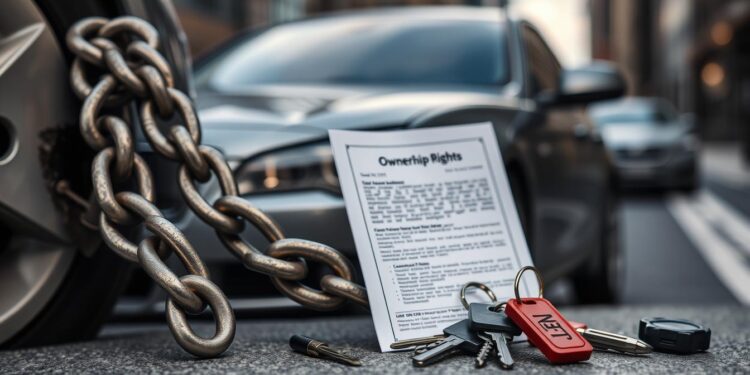
Understanding a lien on a car means exploring the complex world of vehicle ownership. A lien is a legal claim a creditor has on a vehicle. It’s used as security for a debt. When you finance a car, the lender gets a legal right to it until you pay off the loan.
About 20-30% of used cars have an active lien. This affects how you own a vehicle. Liens can come from loans, mechanic bills, or legal judgments. They protect lenders’ money by ensuring they get paid back.
Having a lien on your car means the lender has a legal claim to it. You can’t give the title to someone else until the debt is paid off. This process helps lenders and makes car financing safer.
Table of Contents
- 1 Understanding Car Liens: A Complete Guide
- 2 What Is a Lien on a Car
- 3 Common Reasons for Vehicle Liens
- 4 How Car Liens Work in Practice
- 5 The Rights and Responsibilities of Lienholders
- 6 Vehicle Ownership With an Active Lien
- 7 Steps to Check for Existing Liens
- 8 Purchasing a Car with an Existing Lien
- 9 The Process of Lien Release and Removal
- 10 Impact of Liens on Vehicle Sales
- 11 State Laws and Regulations Regarding Car Liens
- 12 Insurance Requirements for Vehicles with Liens
- 13 How to Avoid Lien-Related Problems
- 14 Conclusion
Key Takeaways
- Liens are legal claims on vehicles serving as debt collateral
- Approximately 20-30% of used cars have active liens
- Lienholders retain legal ownership until full loan repayment
- Liens can originate from multiple financial sources
- Vehicle title transfer requires lien clearance
- Liens protect lender’s financial interests
Understanding Car Liens: A Complete Guide
Car liens are key to owning a vehicle and getting auto financing. They give creditors rights to a car until the debt is paid off.
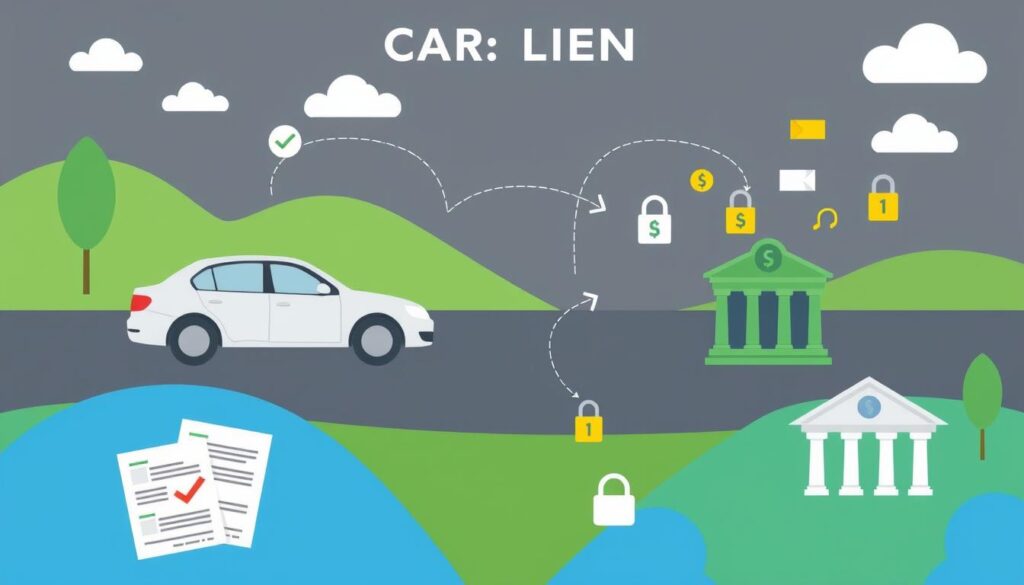
A car lien is a legal document that shows a creditor’s interest in a vehicle. Over 40% of vehicles searched have a lien, showing how common it is.
Legal Definition of a Car Lien
In auto financing, a lien is a legal right. It lets a creditor take the vehicle if payments aren’t made. Creditor rights include:
- Securing the vehicle as collateral
- Potential repossession if payments are missed
- Maintaining legal claim until debt is satisfied
How Liens Impact Vehicle Ownership
Vehicle liens limit an owner’s control. Selling or transferring a car is hard with a lien without clearing the debt first.
“A lien is more than a financial document – it’s a legal claim that protects a creditor’s investment.”
Types of Car Liens Available
| Lien Type | Description | Typical Originator |
|---|---|---|
| Voluntary Lien | Accepted during auto financing | Banks, Credit Unions |
| Involuntary Lien | Placed without owner’s consent | Government, Mechanics |
| Mechanic’s Lien | For unpaid repair services | Auto Repair Shops |
Knowing about car liens helps people deal with vehicle ownership better. It helps them make smart financial choices.
What Is a Lien on a Car
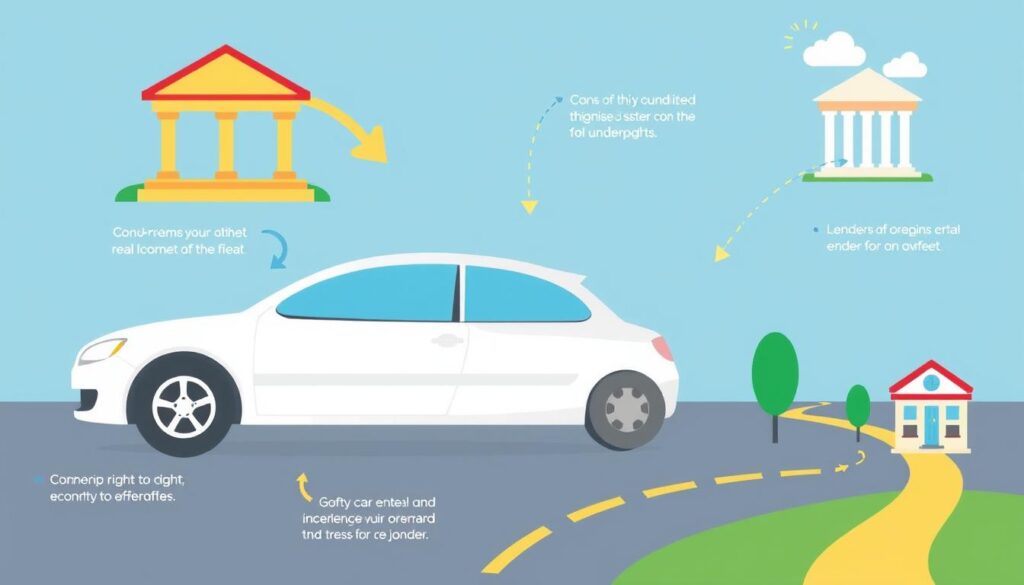
A car lien is a legal claim on a vehicle that protects lenders’ money. It happens when you get a car title loan or finance a car purchase. The lender gets a legal right to the vehicle until you pay off the debt.
Knowing about a lien on a car is key to understanding car financing. It’s a legal way for lenders to feel secure when they lend money for cars.
“A lien serves as a financial safeguard, protecting the lender’s investment in the vehicle.” – Financial Experts
- Lenders place a lien as a security measure
- The vehicle serves as collateral for the loan
- Liens remain active until the entire debt is cleared
Car title loans usually mean a direct lien on the vehicle’s title. The lienholder owns the vehicle legally until you pay off the loan. If you can’t pay, the lender might take the vehicle back.
| Lien Characteristic | Details |
|---|---|
| Average Lien Duration | Length of loan term |
| Lender Protection | Full vehicle ownership until payoff |
| Release Timeframe | 3 business days after final payment |
Key insight: Liens reduce lending risks and enable more accessible vehicle financing options for consumers with varying credit backgrounds.
Common Reasons for Vehicle Liens
Vehicle liens are important for creditors in financial deals. Knowing why they happen helps people deal with car loans better.
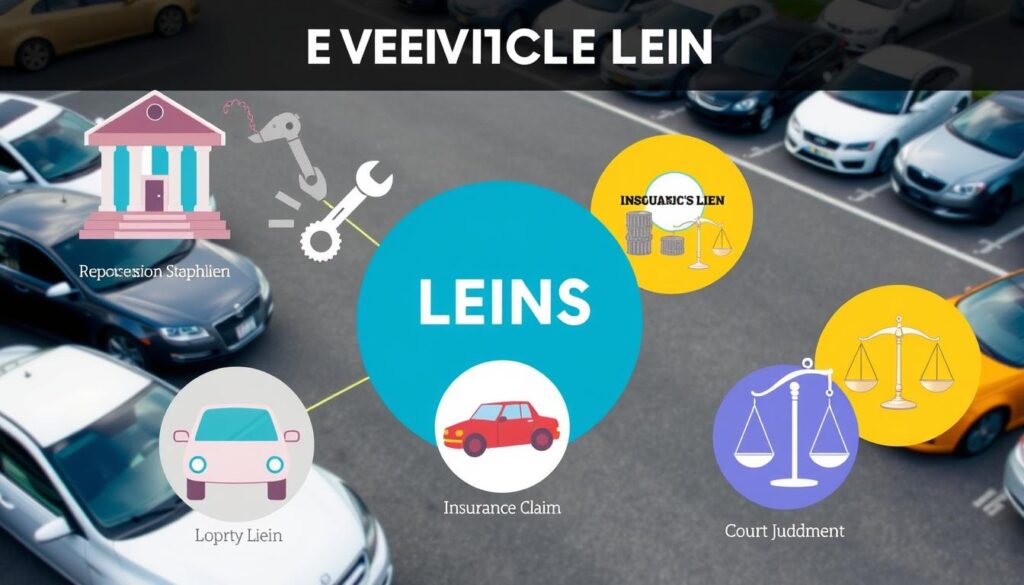
About 95% of cars with loans have liens on them. This shows how common liens are in car deals. Liens come from different situations, each protecting someone’s interest.
Auto Loan Financing
Auto loans are the main reason for liens. When you buy a car with a loan, the lender puts a lien on it. The car is used as collateral, giving the lender rights until the loan is paid off.
- Lenders file liens with state motor vehicle agencies
- Liens are recorded directly on vehicle titles
- Borrowers must maintain complete insurance
Mechanic’s Liens
Mechanic’s liens happen when car repairs are not paid for. Repair shops can claim the car until they get paid. This protects them from losing money.
Tax and Legal Judgments
Government agencies and courts can also put liens on cars. Unpaid taxes, child support, or legal judgments can lead to liens. This way, creditors can get their money back.
A lien acts as a powerful legal tool ensuring financial accountability in vehicle ownership transactions.
It’s important for buyers to watch out for liens. About 60% of buyers don’t check for liens before buying. This can lead to big financial problems.
How Car Liens Work in Practice
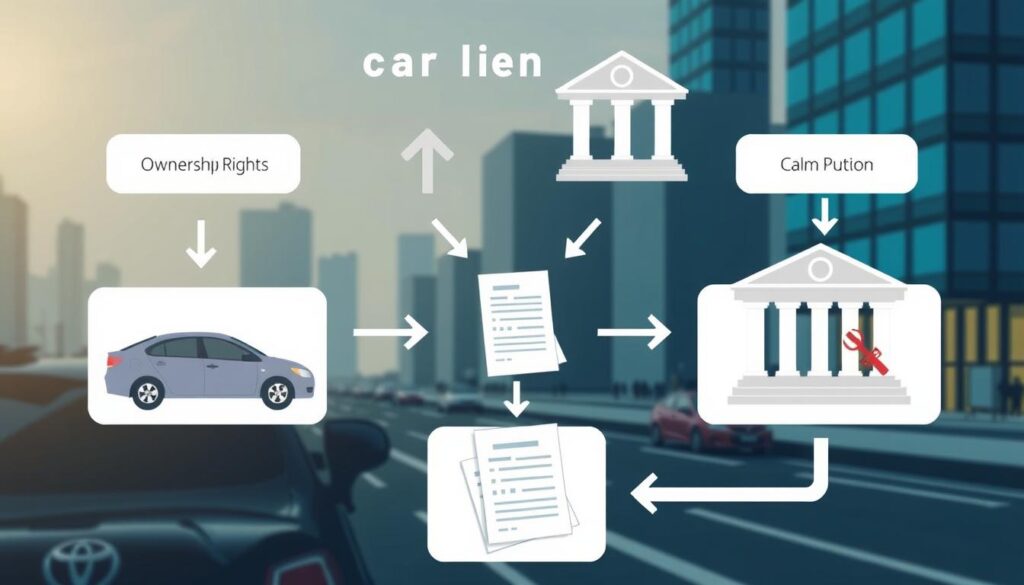
Understanding what a lien on a car means is key for owning a vehicle. A lien is a legal claim that lets a lender secure their financial interest in a car until the debt is paid off.
The lien process has several important steps:
- Initial loan approval triggers the lien creation
- Lender registers legal claim on vehicle title
- Vehicle becomes collateral for the financing
- Borrower maintains possession while making payments
Lien mechanics show a complex relationship between borrowers and lenders. Auto loans are secured loans, giving lienholders certain rights. They can take the vehicle if the borrower doesn’t make payments.
“A lien follows the vehicle, not just the owner” – Financial Expert
To check if a vehicle has a lien, you can use different methods:
- State DMV title search
- Vehicle history reports
- VIN number checking
| Lien Type | Description | Typical Duration |
|---|---|---|
| Auto Loan Lien | Financing secured through banks/credit unions | 3-7 years |
| Mechanic’s Lien | Repairs or service unpaid | Until debt resolved |
| Tax Lien | Outstanding government taxes | Varies by jurisdiction |
Knowing how liens work helps people own vehicles with confidence. It ensures clear financial deals and follows the law.
The Rights and Responsibilities of Lienholders

When a vehicle is financed, lienholders play a key role in protecting their interests. It’s vital for both vehicle owners and financial institutions to know the laws about repossession and creditor rights.
Repossession Rights
Lienholders have clear legal rights in debt collection and vehicle ownership. Every year, about 1.5 million cars are repossessed in the U.S. due to loan defaults. Their main rights include:
- Legal right to reclaim the vehicle if payments are not made
- Ability to initiate debt collection procedures
- Potential sale of the repossessed vehicle to recover outstanding loan balance
Lienholder Payment Requirements
Financial institutions must follow strict rules in debt collection. Failure to provide proper notification can result in legal disputes. Key payment requirements include:
- Clear communication about payment schedules
- Detailed documentation of outstanding debt
- Transparent accounting of financial transactions
“A lienholder’s primary responsibility is to protect their financial interests while maintaining legal and ethical standards in debt collection.”
Legal Obligations to Vehicle Owners
Lienholders must respect vehicle owners’ rights, even with their financial claim. This includes:
- Providing adequate notice before repossession
- Filing appropriate paperwork when the lien is satisfied
- Releasing the lien upon full loan repayment
Studies show that about 40% of debtors report unfair practices during collection. This highlights the need for understanding creditor rights and clear communication.
Vehicle Ownership With an Active Lien
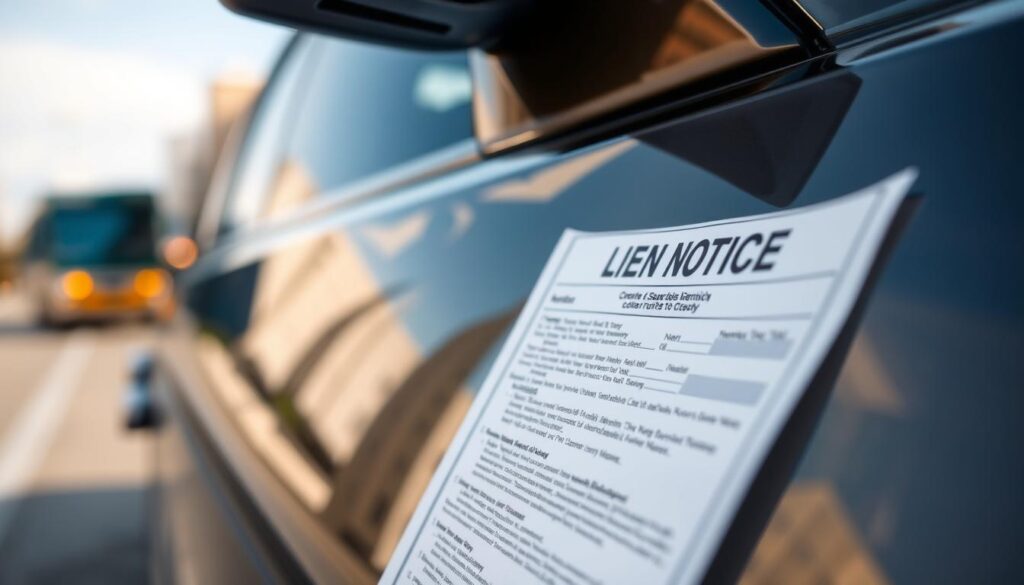
Having a lien on a car brings its own set of challenges. When a car has a lien, the owner and the lienholder, like a bank, share the legal rights. This affects how you own and manage your vehicle.
“A lien represents a legal claim that protects the lender’s financial interest until the loan is fully repaid.”
Important things to think about with a lien on your car include:
- Limited title transfer capabilities
- Mandatory insurance that covers everything
- Strict payment rules
- Risk of the car being taken back
Here are some financial facts about vehicle liens:
| Metric | Value |
|---|---|
| Average Used Vehicle Loan (Q3 2021) | $26,230 |
| Average Monthly Payment | $471 |
| Financed Vehicles Requiring Insurance | 100% |
Lienholders have certain rights when you own a car with a lien. They can ask for certain insurance and can take legal action if payments aren’t made. Vehicle owners must talk to their lienholder and keep their finances open and honest.
Being a responsible car owner with a lien means knowing the rules, making payments on time, and having the right insurance. Borrowers should handle their loan well to avoid losing their car and protect their money.
Steps to Check for Existing Liens
It’s important to check if a car has any liens before buying it. This helps protect your rights as a car owner. Buyers need to look for any liens that could make the deal complicated.
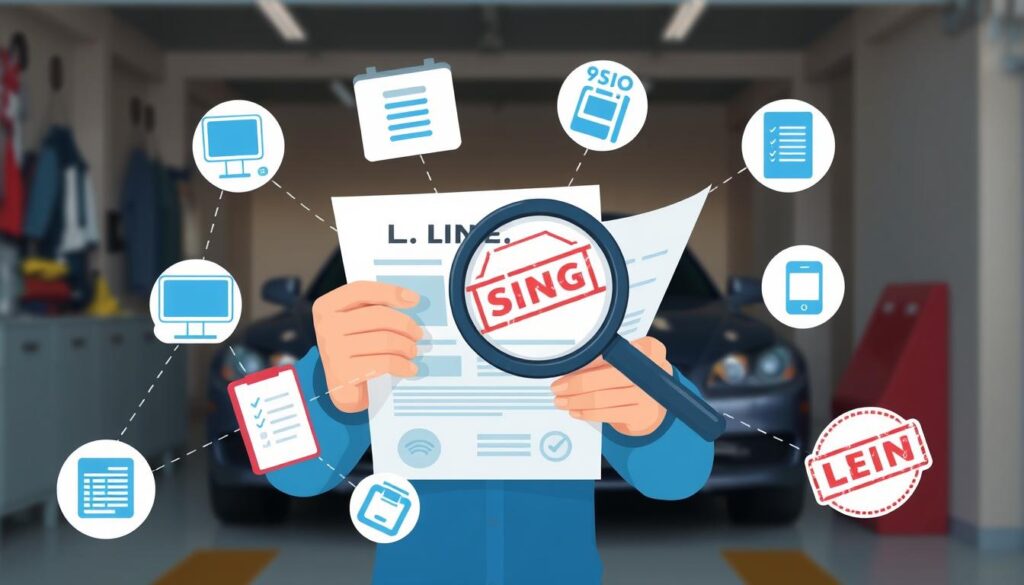
To find out if a car has liens, you need to use different methods. This way, you can find out if there are any financial issues with the car.
DMV Title Search Process
The Department of Motor Vehicles (DMV) is a key place to check for liens. You can:
- Ask for a title search using the Vehicle Identification Number (VIN)
- Pay a small fee for the service
- Get documents that show if there are any liens on the car
Vehicle History Reports
Online services can give you a lot of information about a car’s past. They show:
- Who owned the car before
- If there are any money problems with the car
- If the car might be taken back by the lender
But, surprisingly, about 60% of car buyers don’t check for liens. This can lead to big legal problems.
State Lien Registry Checks
Every state has its own way of checking for liens. You should:
- Call local government offices
- Use online tools to search for liens
- Check both electronic and paper records
“Knowing if a car has a lien is the first step to avoid problems with owning it.”
| Search Method | Cost Range | Processing Time |
|---|---|---|
| DMV Title Search | $5 – $25 | 1-3 Business Days |
| Online Vehicle Report | $20 – $50 | Instant – 24 Hours |
| State Lien Registry | $10 – $30 | 2-5 Business Days |
Understanding liens and doing your homework is key to protecting your investment in a car.
Purchasing a Car with an Existing Lien
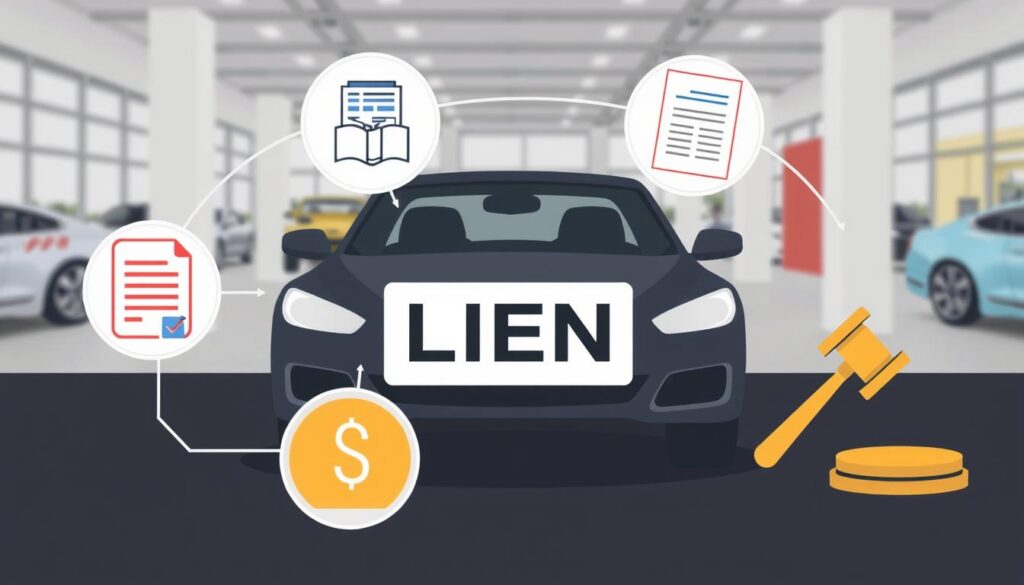
Buying a car with a lien is complex. About 50% of car sales in the U.S. involve financing. This means many cars have liens on them.
“Purchasing a car with an existing lien demands thorough research and strategic planning to protect your investment.”
When buying a car with a lien, there are key steps to follow:
- Verify the existing lien through a detailed vehicle history report
- Confirm the total outstanding loan balance with the current lienholder
- Negotiate payment terms with the seller
- Ensure complete lien release before finalizing the purchase
The process can be complex, with different scenarios:
| Lien Resolution Method | Buyer Risk Level | Recommended Action |
|---|---|---|
| Seller pays off lien | Low | Obtain written proof of lien clearance |
| Buyer pays lien directly | Medium | Use escrow services for secure transaction |
| Transfer existing loan | High | Get lender approval for loan assumption |
Warning: About 30% of private party car sales face lien-related issues. Buyers should be ready for challenges during the process.
Electronic lien and title (ELT) programs are becoming more common. They make transferring ownership easier. But, buyers must do their homework to safeguard their investment in auto financing.
The Process of Lien Release and Removal
Understanding the lien release process is key for car owners. It’s important to know how to remove a lien to get full auto equity and clear ownership.
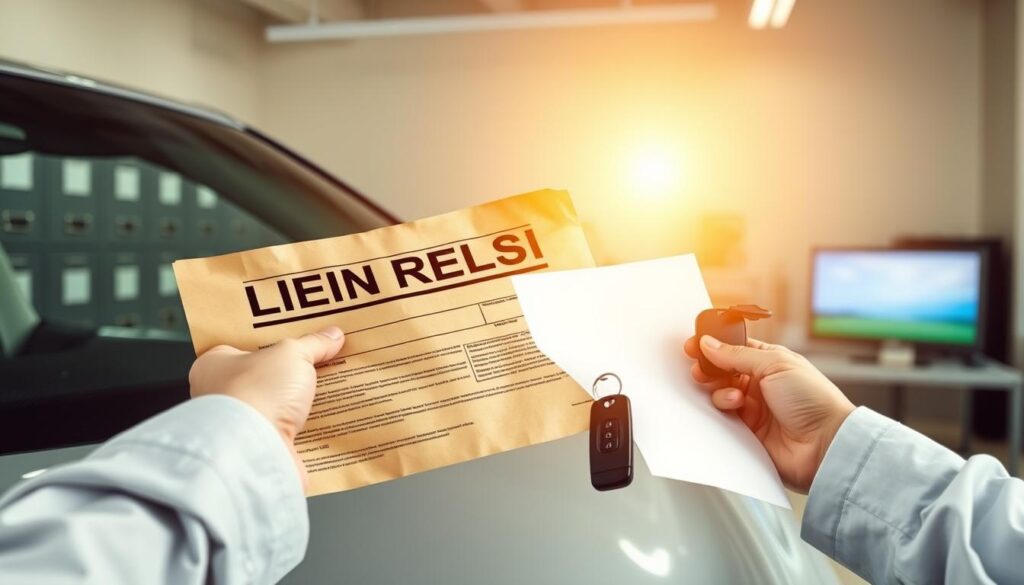
When you pay off a car loan, getting the lien released is a big step. It shows you own the car fully. About 85% of car buyers finance their purchases, so this is a common process.
Documentation Requirements
To get a lien released, you need a few important documents:
- Proof of full loan payoff
- Original loan agreement
- Vehicle title
- Lien release form from the lender
Timeline for Lien Removal
Lenders usually release liens within 30 days after you pay off the loan. The time it takes can vary based on the lender’s rules.
| Lien Release Stage | Typical Timeframe |
|---|---|
| Loan Payoff Confirmation | 1-5 business days |
| Lien Release Documentation | 7-21 business days |
| DMV Title Update | 14-30 business days |
Legal Verification Steps
To verify a lien release, follow these steps:
- Contact the original lender for official lien release documents
- Submit documents to local DMV
- Request an updated vehicle title
- Confirm removal through state vehicle records
“Diligence in the lien release process protects your auto equity and ensures smooth vehicle ownership transfer.”
About 70% of first-time car buyers don’t know about lien releases. Knowing these steps helps owners smoothly transfer car ownership.
Impact of Liens on Vehicle Sales
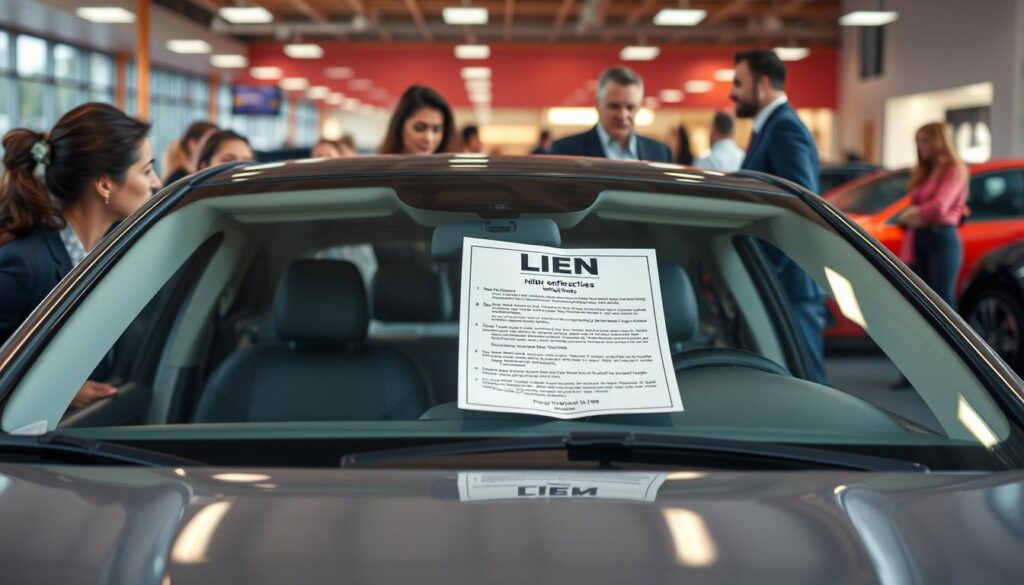
Selling a car with an active lien is tough. About 40% of car sales happen while the car is under a lien. It’s key to grasp the details of this process.
With a lien on a vehicle, sellers hit several hurdles:
- Potential buyers might shy away from a car with debt
- Transferring the title gets harder
- More paperwork is needed to remove the lien
Vehicle ownership gets complicated with a lien. Stats show 70% of private buyers want cars without liens. But, they might negotiate if the price is right.
“A lien represents a legal claim against a vehicle, directly impacting its marketability and sale.
Sellers have ways to deal with liens during sales:
- Pay off the lien before selling
- Work with the lienholder to sell the car
- Share clear documents with buyers
| Sale Scenario | Lien Impact | Resolution Time |
|---|---|---|
| Private Sale | Higher Complexity | 1-3 Weeks |
| Dealership Trade-In | Lower Complexity | Few Hours |
Navigating a vehicle sale with an existing lien needs careful planning and clear talks between all parties.
State Laws and Regulations Regarding Car Liens
Understanding car liens means knowing the rules of each state. Laws about repossessions and what creditors can do vary a lot. It’s important for car owners and buyers to know these rules.
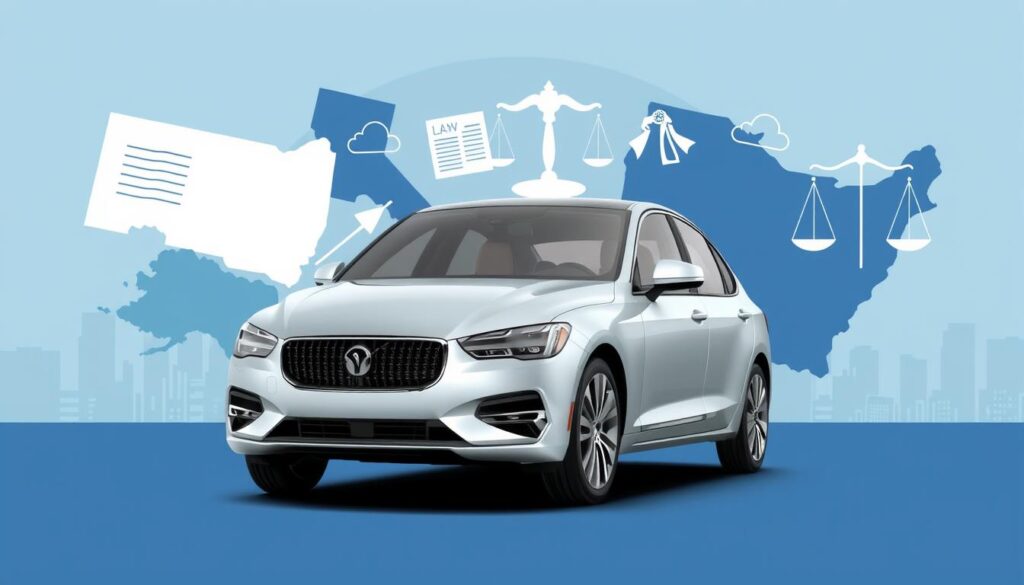
Every state has its own way of handling car liens. This affects who owns the car and who owes money. The rights of lenders and borrowers are different, making things tricky.
- Lien recording procedures vary by state
- Enforcement mechanisms differ across jurisdictions
- Repossession laws have significant regional variations
States have their own ways of dealing with car liens. For example, some states need more paperwork for liens, while others are easier.
| State Characteristic | Lien Recording Impact |
|---|---|
| New York | Requires specific “release of lien” attached to title |
| North Carolina | DMV directly manages title issuance to lenders |
| California | More complex borrower verification processes |
“Understanding state-specific lien regulations is key to protecting your vehicle ownership rights.” – Legal Vehicle Finance Expert
Approximately 40% of vehicles on the road currently have active liens. This shows how important it is to know these laws. Car owners need to understand repossession laws to keep their cars and money safe.
The rules for car liens are complex. This means you need to do your homework and get help from experts when dealing with car loans and ownership.
Insurance Requirements for Vehicles with Liens
Having a lien on a vehicle means you must follow certain insurance rules. These rules help protect both you and the person who has a lien on the vehicle. Auto financing adds extra insurance needs that are more than just the state’s minimum.
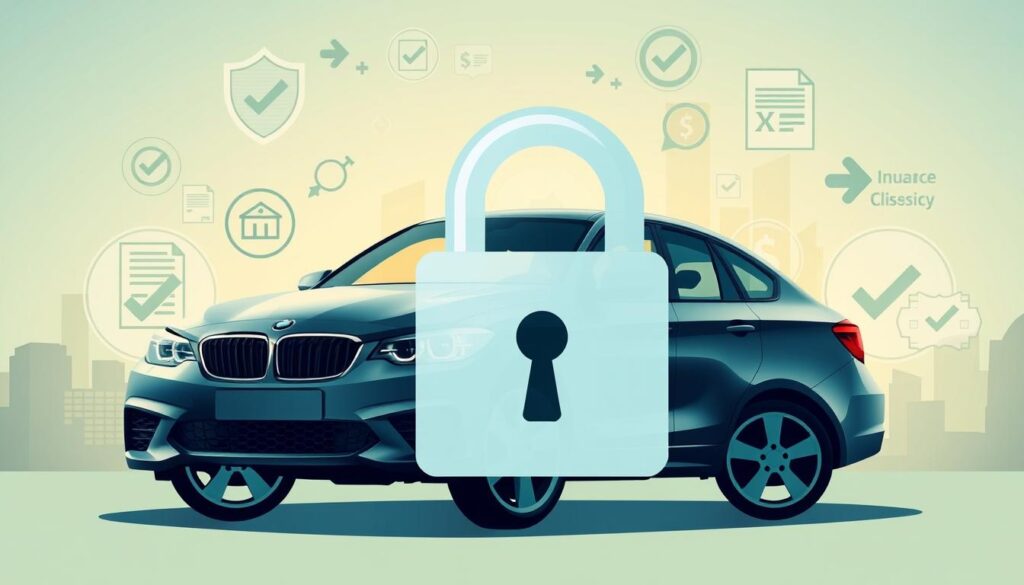
Lienholders want full coverage to keep their money safe. They make sure the vehicle is fully covered while you’re paying off the loan.
Required Coverage Types
When you finance a vehicle, you must have certain insurance types. Lenders require these to keep the vehicle safe:
- Comprehensive coverage for non-collision damages
- Collision insurance for accident-related repairs
- Liability protection meeting minimum state requirements
- Gap insurance for possible value differences
Lienholder Insurance Provisions
Financial institutions have rules to protect their money when you finance a vehicle. These rules include:
- Naming the lienholder as an additional insured party
- Providing proof of insurance documents
- Keeping insurance active for the whole loan term
“Full coverage does not represent an official insurance category, but represents complete protection for financed vehicles.”
| Insurance Type | Coverage Purpose | Lienholder Requirement |
|---|---|---|
| Comprehensive | Protection against theft, natural disasters | Typically Mandatory |
| Collision | Accident-related vehicle damage | Typically Mandatory |
| Gap Insurance | Cover value difference in total loss | Often Recommended |
Vehicle owners need to understand these insurance rules. They help keep your financing agreement in order and protect your rights to the vehicle.
How to Avoid Lien-Related Problems
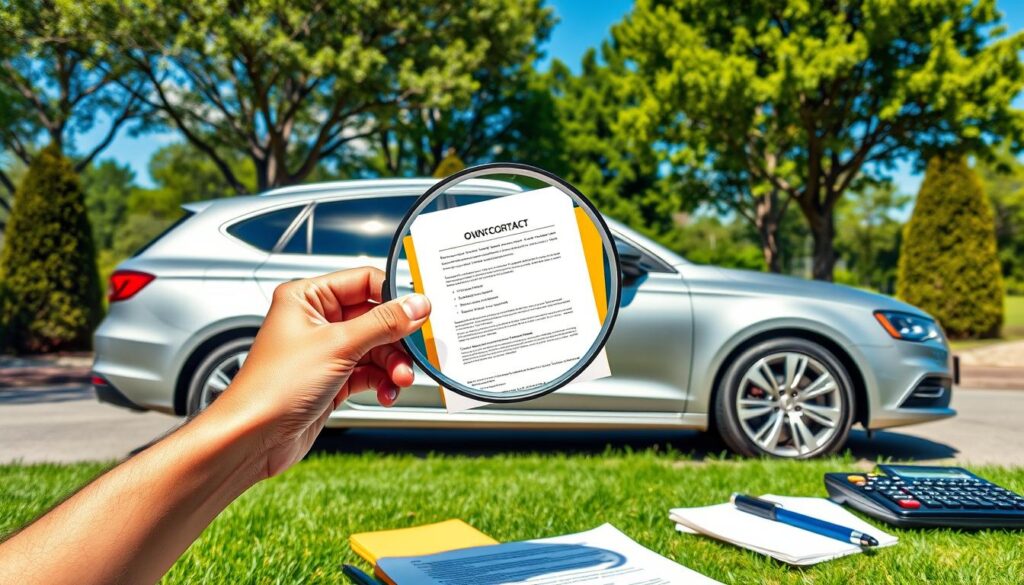
Knowing about liens on cars can help owners avoid money troubles. Managing auto equity well is key to avoiding lien issues.
Both buyers and sellers need to take steps to avoid lien problems:
- Do thorough checks on the vehicle’s history
- Make sure the title is clean before buying
- Keep accurate financial records
- Be open about any financial obligations
Before buying a used car, do this:
- Get a detailed vehicle history report
- Check the state lien registry
- Make sure there are no outstanding claims
- Work out lien clearance with the seller
“Prevention is always better than cure when dealing with vehicle liens.” – Financial Expert
| Action | Purpose | Recommended Frequency |
|---|---|---|
| Title Search | Verify Vehicle Ownership Status | Before Every Purchase |
| Credit Report Review | Check Financial Standing | Annually |
| Loan Payment Tracking | Prevent Involuntary Liens | Monthly |
Building auto equity means making regular payments and keeping the car in good shape. Understanding your loan terms is also important. This way, you can avoid unexpected liens and keep your car for a long time.
Conclusion
Buying a car comes with many financial details, like liens. Over 30% of car loans have a lien on the vehicle. It’s key for buyers to know about these claims.
A lien is a financial hold that affects a car’s value and the owner’s money options. It’s not just a small detail but a big legal tool.
Car liens involve complex laws and money matters. About 15% of borrowers might lose their car due to insurance issues. This shows how important it is to understand liens well.
Knowing about liens is essential for smart car deals. Whether it’s a bank lien, mechanic’s lien, or tax lien, research is needed. 40% of creditors delay filing liens, which can lead to big legal and money problems.
To handle car liens, you need to pay attention to legal and money matters. Knowing about liens helps protect your car and money. With the right knowledge, you can manage these complex car financial issues well.






